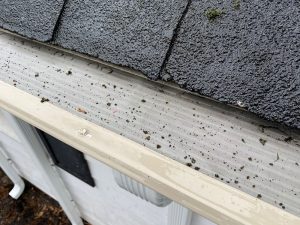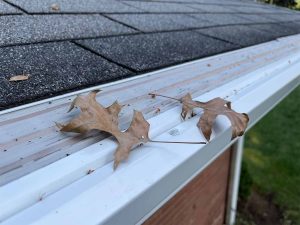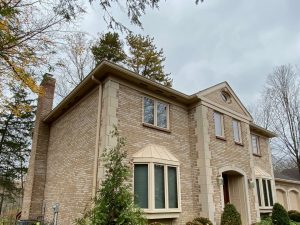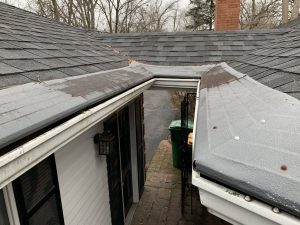Odds are the last thing you want to do after you buy a new home is get into the gutter cleaning business.
That’s exactly what this Nolensville, Tennessee, homeowner learned that he would have to do after they built this custom home at the end of the street. The homeowners picked this lot because it was at the end of the street, under a couple of large Oak trees.
The couple had no intention of cutting down the trees, but they also had no plans to regularly clean their gutters.
They reached out to us and asked if we could help them with their leaf and debris problem. It was evident upon arrival that they had a problem. They already had plenty of leaves and small branches that had dropped into the gutters behind the garage, and with some of those gutters on the 2nd level, the problem was going to get worse before it got better.
Because they have oak trees and because they have a steep pitched roof with several valleys (where two roof surfaces meet), we recommended micro mesh gutter guards as the best option. Unfortunately, the house had 5″ gutters. Being new, the couple had no interest in upsizing to 6-inch gutters.
We showed them 4-different gutter guards: Gutter Rx, LeaFree, LeafLock and MasterShield.
Money was an issue, so they had been focusing their attention on a Gutter Rx type system. I don’t recall if they were contemplating Leaf Relief or ShurFlo, two flat paneled gutter guards with holes drilled into the surface, but I told them that installing any of those systems would be a mistake.
Why would installing perforated aluminum gutter guards be a mistake?
The answer is simple. Gutter Rx, Leaf Relief and ShurFlo are all designed to sit flat inside the gutters. By sitting flat, the leaf guards create a shelf on top of the gutters. As the oak tassels, leaves, sticks, twigs and acorns fall from the trees, they’ll land on top of and sit on the “shelf.”
That’s a problem with Oak trees, and many other trees, frankly. Since the trees are literally overhanging the house on the back side of the garage, while any of these gutter guards would have done an effective job keeping leaves and the accompanying debris out of the gutters, it would have piled on top of the gutter guards, requiring someone to clean them off on a regular basis.
Some might argue that a little breeze would be adequate to blow-off whatever is sitting on top of the gutter guards to the ground. That’s generally not the case, and wouldn’t have been the situation here because the trees form a canopy over the roof, and the roof a barrier to allowing wind to whip through unimpeded in this area.
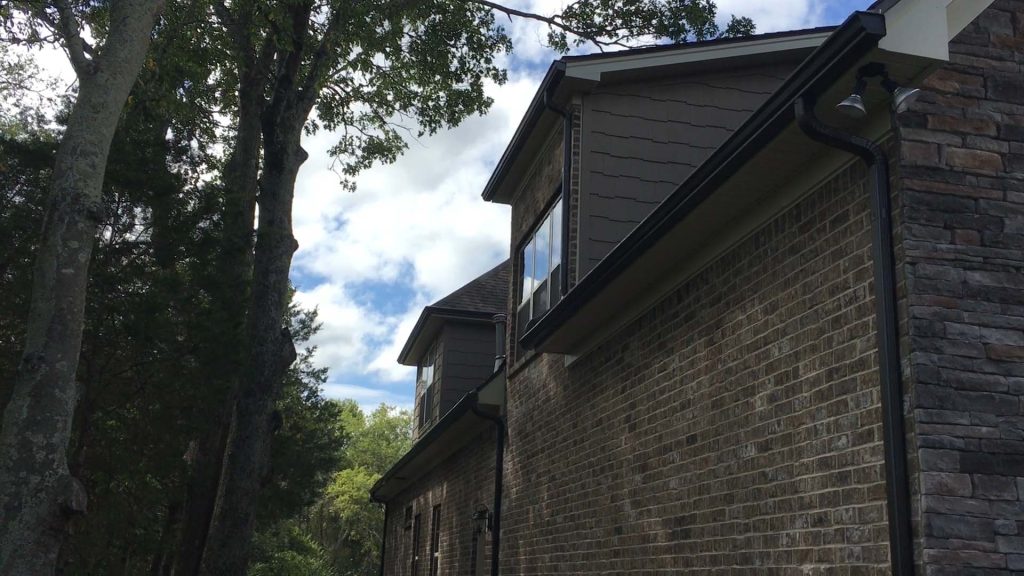
Micro Mesh Gutter Guards on a Budget
We recommended MasterShield gutter guards for this project. But, as I said earlier, the homeowner was looking for a more budget-friendly gutter guard. The runner up, in this case, was LeafLock, a mid-tier micro mesh gutter guard that will keep out almost everything while letting in a decent amount of water into the gutters.
Another cost-cutting move these folks undertook was not installing gutter guards on all of their gutters. They believed that they wouldn’t get much in the way of leaves in their back gutters because the trees in the backyard were quite a distance away from the house.
While we don’t generally recommend skipping an area unless you’re pretty darn confident that the leaves won’t visit, we were able to end the gutter guards at natural stopping points — end of runs — so that no gutter runs were left exposed.
The issue with installing gutter guards on a portion of a gutter run, say 15-feet of a 30-foot run, would be that leaves and debris can get into the section of gutter that you didn’t cover, potentially causing problems for the uncovered and covered sections of gutter. In this case, we left exposed only whole sections of gutters that the homeowners didn’t want covered.
Extend Downspouts to Get as Much Water Off the Roof as Possible
We also recommended that the homeowners extend all of the downspouts from the upper sections of gutter into the lower gutters. Why gutter installers don’t do this by default is beyond me. Actually, it’s not beyond me. They and/or the builders do it to save money, time, and because the often don’t know any better. But we know better!
Not extending downspouts is a surefire way to shorten your roof’s lifespan because it will cause the roofing granules to wash away more quickly. This will also cause the shingles to discolor in areas where the heavier water flows are present. It can cause damage to the siding and brick veneer in the form of wood rot, decaying Hardie plank siding, and discoloring bricks.
You will also experience much higher volumes of water where the downspout ends on the roof. This often overwhelms lower gutters, creating spillover at ground level. Overflowing water further complicates matters because, at best, it’ll mess up your mulch, and, at worst, it can cause water in basements, crawl spaces and entryways.
New House, New Gutters, Plus New Gutter Guards Equals No More Gutter Cleaning Headaches
The bottom line is that the homeowners opted for LeafLock micro mesh gutter guards and asked us to extend the downspouts from the upper gutters into the lower gutters. Upgrading to micro mesh gutter guards cost them a bit more money upfront, but it will save thousands of dollars in gutter cleaning bills they would have incurred had they opted for the “shelf-like” gutter covers. Plus, extending the downspouts was an easy and cost-effective way to eliminate costly water problems that would have occurred had we not made the recommendation.



